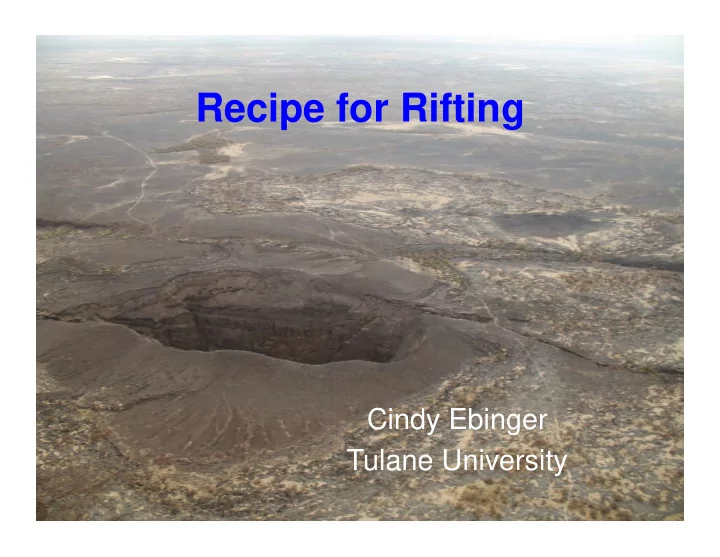

Recipe for Rifting Cindy Ebinger Tulane University
King Cake AGU 2017 in New Orleans
Volcanic systems respond to tectonic forces; density contrasts, fluid pressures modify ambient stress field glacial unloading rheology-dependent behavior Ebinger et al., 2013
Foundations I Scales and architecture of extensional systems spatially variable. Endmembers, plus all between 1) ‘cratonic’ rifts – develop in cold lithosphere 2) ‘orogenic’ rifts – develop in collapsing orogens where crust is hot, mantle may be hydrated Differences confirm critical importance of crust and mantle rheology
Rheology - We know we need to know hydration state and composition of lower crust, but we have few tools to measure in situ: Density Vp, Vs, Vp/Vs Xenoliths Magma petrology Volatiles as inclusions, soil and water measurements AR Lowry & M Pérez-Gussinye Nature 471 , 353-357 (2011) doi:10.1038/ nature09912
Mineralogical reactions and enhanced geothermall gradients = considerable complexity in Vp and Vs; Compressible (volatiles) vs incompressible fluids (magma) changes Vp/Vs
� � � � � � W (35,2.33S) Natron-Magadi Basin A-A’ E(37, 2.33S) 5 4 Initiation of magmatic Intrusion zone? 3 segment? 2 CO 2 CO 2 1 0 Archaean -10 craton -20 Vp/Vs 1.75 Vp/Vs 1.75 Vp/Vs = 1.70 -30 Vp/Vs 1.82 mantle lithosphere Vp/Vs 1.7 -40 0 20 40 60 80 100 120 140 160 180 200 220 Vp/Vs ~1.65 -CO2 as pore-filling fluid S-wave velocities; ANT, body wave, gravity joint inversion –Roecker et al., GJI, 2017; RF – Plasman et al. GJI, 2017; Weinstein et al., in review
Foundations II Rocks are weak in extension Extensional strains widely distributed in continental regions • Scale with mantle upwelling • Orogen
Hammond and Thatcher, JGR, 2007
15˚ Extensional strain and magmatism beneath > 100 Afar 10˚ km-thick lithosphere widely MER distributed – what is stable? 5˚ Turkana A-E-K Seismic moment release Eastern Rift Lakes 0˚ using NEIC (complete to ca M 4.5). TZ Divergence -5˚ Tangan- M 0 = µ As where is shear yika modulus of rock at EQ Malawi -10˚ source, and A is area of fault plane, and s is slip Davie Ridge -15˚ South ~10^2 y of 10^3-10^5 y Western -20˚ interseismic cycle -25˚ 30˚ 25˚ 35˚ 40˚ 45˚ km Lindsey et al., submi tu ed -4 -3 -2 -1 0 1 2 3 4 Fig. 3
Foundations III Cratons are too strong to rift, yet they do. Magma- assisted rifting is important, but can’t generate magma under thick lithosphere. Additional forces + strength reducers: A) Cratonic roots and slabs divert mantle flow, enabling enhanced melt production and tractions + volatile release. B) Metasomatism – volatile-enriched mantle from prior subduction; mantle upwelling Jolante, Tyrone talks
Edge-driven convection initiates at sharp boundary. Craton edge preserved only where cratonic mantle is dry and > 5 times stronger Currie, van Wijk, J. Geodynamics, 2016
Aims: Use shear wave splitting Sleep et patterns (SKS, SKKS) to evaluate al. 2002 craton edge flow diversion; fluids Sensitive to LAB dip Contributions from LPO; oriented melt pockets (OMP); layered melt Up to 2 s splitting Data: New results from E, SW, NW margins of Tanzania craton (Tepp, Obrebski et al.) Holtzman and Kendall, 2010
Gabrielle Tepp a-axis aligned with flow diverted between cratonic keels along rift thin zones? 17-0 Ma Rungwe volcanic province
Craton-edge signal? Barruol & Ismail KMBO Archaean mantle (xenoliths) Albaric et al., G-cubed, 2014 + this study
Foundations IV Strain localization within the crust strongly influenced by volatiles and magma Rapid stressing by magma intrusion, high pore pressures, super-critical CO 2 may induce lower crustal fault zones that localize strain and promote creep/slow-slip processes. – Muirhead talk to follow
Large strain, steady-state rheological models for phyllosilicates allow for foliation development, cataclasis, pressure-solution - show velocity- dependent behavior A = plastic flow in 25 o C/km phyllosilicates B = frictional slip over 15 o C/km foliae C = pressure solution 35 o C/km controlled strength D = dilatational Fluid-assisted cataclasis – sliding by weakening dilatation 25 o C/km – what Niemeijer & Spiers, about greater depths, Geol Soc London super-critical CO 2 , higher gradients? 2005;
Recipe for Strain Localization • Start with LAB topography and enhanced mantle tractions/small- scale convection. Use this to produce: • Small volume melting. • Release some volatiles to explode some kimberlites, lamproites,and to • Metasomatise mantle lithosphere and lower crust to reduce strength, increase melt production. If ‘rapid rise’ results needed, start with previously metasomatised mantle. • Keep elevated to encourage high GPE • Allow volatile expansion to increase fluid pathways, and fill pores to further reduce strength • Intrude magma to expedite heat transfer and enhance strain localization • Volatile percolation along fault zones to reduce friction and enable slip at lower stressing rates • Enhanced erosion and sediment loading = icing on ‘cake’ * Note: If rupture required, maintain upwelling or far-field stresses * Take with pinch of salt
What do we need to enjoy a better rift ‘cake’ ? • ! Rock mechanics experiments at lower crustal conditions – super-critical CO 2 and fault friction • ! Direct observation of lower crust and upper mantle hydration - xenolith, fluid inclusion, Vp/Vs, MT • ! Continuous GPS and seismic monitoring along active fault zones – does aseismic creep occur in fluid-rich rift zones? • ! Quantify magma intrusion rates across range of settings • ! Compare and contrast crustal and mantle anisotropy patterns – role of fluid-filled fractures vs strain fabrics
Recommend
More recommend